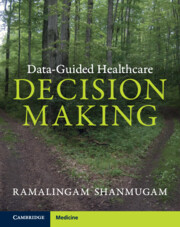Book contents
- Data-Guided Healthcare Decision-Making
- Data-Guided Healthcare Decision-Making
- Copyright page
- Dedication
- Contents
- Figures
- Tables
- About the Author
- Preface
- Glossary
- Notations and Symbols
- Prologue
- Introduction
- Chapter 1 Why and How Healthcare Decisions Are Made
- Chapter 2 Are Data-Guided Healthcare Decisions Superior?
- Chapter 3 Software
- Chapter 4 How to Collect Authentic Data
- Chapter 5 Uncertainties and Their Impact on Healthcare Decisions
- Chapter 6 Why Models Are Important in Healthcare
- Chapter 7 How Healthcare Decision Trees Emerge and Function
- Chapter 8 How Are Group Decisions Practiced in Healthcare?
- Chapter 9 Tracing and Remedying Root Causes of Adversities
- Chapter 10 Healthcare Decision-Making for Cost-Effectiveness
- Chapter 11 Risk Analysis in Healthcare Decision-Making
- Chapter 12 Evaluation of Healthcare Programs
- Chapter 13 Six Sigma and Lean Management in Healthcare Sectors
- Chapter 14 Forecasting in Healthcare Sectors
- Epilogue
- Appendix Statistical Tables
- Index
- References
Chapter 6 - Why Models Are Important in Healthcare
Published online by Cambridge University Press: 13 July 2023
- Data-Guided Healthcare Decision-Making
- Data-Guided Healthcare Decision-Making
- Copyright page
- Dedication
- Contents
- Figures
- Tables
- About the Author
- Preface
- Glossary
- Notations and Symbols
- Prologue
- Introduction
- Chapter 1 Why and How Healthcare Decisions Are Made
- Chapter 2 Are Data-Guided Healthcare Decisions Superior?
- Chapter 3 Software
- Chapter 4 How to Collect Authentic Data
- Chapter 5 Uncertainties and Their Impact on Healthcare Decisions
- Chapter 6 Why Models Are Important in Healthcare
- Chapter 7 How Healthcare Decision Trees Emerge and Function
- Chapter 8 How Are Group Decisions Practiced in Healthcare?
- Chapter 9 Tracing and Remedying Root Causes of Adversities
- Chapter 10 Healthcare Decision-Making for Cost-Effectiveness
- Chapter 11 Risk Analysis in Healthcare Decision-Making
- Chapter 12 Evaluation of Healthcare Programs
- Chapter 13 Six Sigma and Lean Management in Healthcare Sectors
- Chapter 14 Forecasting in Healthcare Sectors
- Epilogue
- Appendix Statistical Tables
- Index
- References
Summary
A model is a description of the system that generates data. Box commented that some models are useful, but many are wrong. A reason exists for such a belief (Box, 2013). Nature functions in accordance with mysterious principles. Do such principles precisely fit the mathematical system humans have created? An example of such a mathematical system is the calendar. Over millennia, astronomers, scientists, and philosophers have struggled to redefine and refine the calendar. Different Tamil, Greek, Egyptian, and Sumerian calendars exist, but scholars realized an adjustment is necessary every four years to the number of days in the month of February. The current Gregorian calendar was introduced as an improvement on the Julian calendar in 1582. In a similar way to developing the calendar, modeling the chance-oriented healthcare system is a formidable task even for experts.
What is a model value? In general, values are depictions of a decision maker’s priorities. Model values are not unique to the healthcare field. Model values originated in finance. Swiss mathematician and physicist Daniel Bernoulli (1738) states money’s value decreases over time.
- Type
- Chapter
- Information
- Data-Guided Healthcare Decision Making , pp. 156 - 187Publisher: Cambridge University PressPrint publication year: 2023



